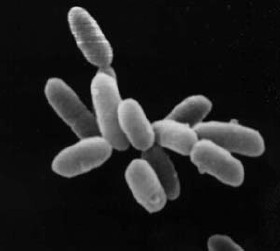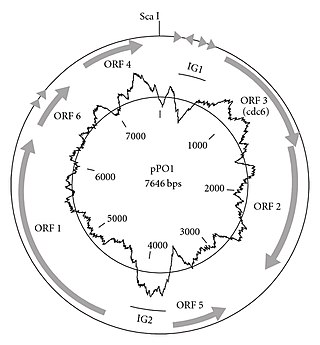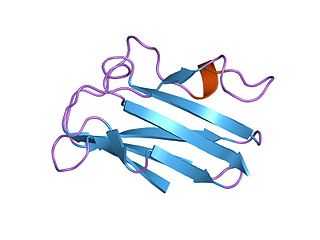Related Research Articles

Euryarchaeota is a phylum of archaea. Euryarchaeota are highly diverse and include methanogens, which produce methane and are often found in intestines; halobacteria, which survive extreme concentrations of salt; and some extremely thermophilic aerobes and anaerobes, which generally live at temperatures between 41 and 122 °C. They are separated from the other archaeans based mainly on rRNA sequences and their unique DNA polymerase.

Acidithiobacillus is a genus of the Acidithiobacillia in the phylum "Pseudomonadota". This genus includes ten species of acidophilic microorganisms capable of sulfur and/or iron oxidation: Acidithiobacillus albertensis, Acidithiobacillus caldus, Acidithiobacillus cuprithermicus, Acidithiobacillus ferrianus, Acidithiobacillus ferridurans, Acidithiobacillus ferriphilus, Acidithiobacillus ferrivorans, Acidithiobacillus ferrooxidans, Acidithiobacillus sulfuriphilus, and Acidithiobacillus thiooxidans.A. ferooxidans is the most widely studied of the genus, but A. caldus and A. thiooxidans are also significant in research. Like all "Pseudomonadota", Acidithiobacillus spp. are Gram-negative and non-spore forming. They also play a significant role in the generation of acid mine drainage; a major global environmental challenge within the mining industry. Some species of Acidithiobacillus are utilized in bioleaching and biomining. A portion of the genes that support the survival of these bacteria in acidic environments are presumed to have been obtained by horizontal gene transfer.

Sulfolobus is a genus of microorganism in the family Sulfolobaceae. It belongs to the archaea domain.

A thermoacidophile is an extremophilic microorganism that is both thermophilic and acidophilic; i.e., it can grow under conditions of high temperature and low pH. The large majority of thermoacidophiles are archaea or bacteria, though occasional eukaryotic examples have been reported. Thermoacidophiles can be found in hot springs and solfataric environments, within deep sea vents, or in other environments of geothermal activity. They also occur in polluted environments, such as in acid mine drainage.

In taxonomy, the Thermoplasmata are a class of the Euryarchaeota.

In taxonomy, Picrophilus is an archaean genus of the family Picrophilaceae.
Biomining ( phytomining) is the concept of extracting metals from ores and other solid materials typically using prokaryotes, fungi or plants (phytoextraction. These organisms secrete organic compounds that chelate metals from the environment. The proposed technology is often aimed at extraction of iron, copper, zinc, gold, uranium, and thorium. Large chemostats of microbes can be grown to leach metals from their media. If it were practical, biomining would be an environmentally friendly alternative to traditional mining.

Plastocyanin/azurin family of copper-binding proteins is a family of small proteins that bind a single copper atom and that are characterised by an intense electronic absorption band near 600 nm. The most well-known members of this class of proteins are the plant chloroplastic plastocyanins, which exchange electrons with cytochrome c6, and the distantly related bacterial azurins, which exchange electrons with cytochrome c551. This family of proteins also includes amicyanin from bacteria such as Methylobacterium extorquens or Paracoccus versutus that can grow on methylamine; auracyanins A and B from Chloroflexus aurantiacus; blue copper protein from Alcaligenes faecalis; cupredoxin (CPC) from Cucumis sativus (Cucumber) peelings; cusacyanin from cucumber; halocyanin from Natronomonas pharaonis, a membrane-associated copper-binding protein; pseudoazurin from Pseudomonas; rusticyanin from Thiobacillus ferrooxidans; stellacyanin from Rhus vernicifera ; umecyanin from the roots of Armoracia rusticana (Horseradish); and allergen Ra3 from ragweed. This pollen protein has evolutary relation to the above proteins, but seems to have lost the ability to bind copper. Although there is an appreciable amount of divergence in the sequences of all these proteins, the copper ligand sites are conserved.

Archaea is a domain of single-celled organisms. These microorganisms lack cell nuclei and are therefore prokaryotes. Archaea were initially classified as bacteria, receiving the name archaebacteria, but this term has fallen out of use.

The outflow of acidic liquids and other pollutants from mines is often catalysed by acid-loving microorganisms; these are the acidophiles in acid mine drainage.
Alicyclobacillus is a genus of Gram-variable, rod-shaped, spore-forming bacteria. The bacteria are able to grow in acidic conditions, while the spores are able to survive typical pasteurization procedures.

Acidithiobacillus ferrooxidans is a bacterium that sustains its life cycle at extremely low pH values, and it is one of the very few organisms that gain energy from oxidating ferrous iron. It can make copper from ores water-soluble, and it can sequester both carbon and nitrogen from the atmosphere.

Acetobacter aceti is a Gram-negative bacterium that moves using its peritrichous flagella. Louis Pasteur proved it to be the cause of conversion of ethanol to acetic acid in 1864. It is a benign microorganism which is present everywhere in the environment, existing in alcoholic ecological niches which include flowers, fruits, and honey bees, as well as in water and soil. It lives wherever sugar fermentation occurs. It grows best in temperatures that range from 25 to 30 degrees Celsius and in pH that ranges from 5.4 to 6.3. For a long time it has been used in the fermentation industry to produce acetic acid from alcohol. Acetobacter aceti is an obligate aerobe, which means that it requires oxygen to grow.
Sulfolobus metallicus is a coccoid shaped thermophilic archaeon. It is a strict chemolithoautotroph gaining energy by oxidation of sulphur and sulphidic ores into sulfuric acid. Its type strain is Kra 23. It has many uses that take advantage of its ability to grow on metal media under acidic and hot environments.
Acidithiobacillus caldus formerly belonged to the genus Thiobacillus prior to 2000, when it was reclassified along with a number of other bacterial species into one of three new genera that better categorize sulfur-oxidizing acidophiles. As a member of the Gammaproteobacteria class of Pseudomonadota, A. caldus may be identified as a Gram-negative bacterium that is frequently found in pairs. Considered to be one of the most common microbes involved in biomining, it is capable of oxidizing reduced inorganic sulfur compounds (RISCs) that form during the breakdown of sulfide minerals. The meaning of the prefix acidi- in the name Acidithiobacillus comes from the Latin word acidus, signifying that members of this genus love a sour, acidic environment. Thio is derived from the Greek word thios and describes the use of sulfur as an energy source, and bacillus describes the shape of these microorganisms, which are small rods. The species name, caldus, is derived from the Latin word for warm or hot, denoting this species' love of a warm environment.
Sulfolobus acidocaldarius is a thermoacidophilic archaeon that belongs to the phylum Thermoproteota. S. acidocaldarius was the first Sulfolobus species to be described, in 1972 by Thomas D. Brock and collaborators. This species was found to grow optimally between 75 and 80 °C, with pH optimum in the range of 2-3.
Metallosphaera sedula is a species of Metallosphaera that is originally isolated from a volcanic field in Italy. Metallosphaera sedula can be roughly translated into “metal mobilizing sphere” with the word “sedulus” meaning busy, describing its efficiency in mobilizing metals. M. sedula is a highly thermoacidophilic Archaean that is unusually tolerant of heavy metals.
Galdieria sulphuraria is an extremophilic unicellular species of red algae. It is the type species of the genus Galdieria. It is known for its broad metabolic capacities, including photosynthesis and heterotrophic growth on over 50 different extracellular carbon sources. The members of the class Cyanidiophyceae are among the most acidophilic known photosynthetic organisms, and the growth conditions of G. sulphuraria – pH between 0 and 4, and temperatures up to 56 °C – are among the most extreme known for eukaryotes. Analysis of its genome suggests that its thermoacidophilic adaptations derive from horizontal gene transfer from archaea and bacteria, another rarity among eukaryotes.

"Candidatus Aciduliprofundum boonei" is an obligate thermoacidophilic candidate species of archaea belonging to the phylum "Euryarchaeota". Isolated from acidic hydrothermal vent environments, "Ca. A. boonei" is the first cultured representative of a biogeochemically significant clade of thermoacidophilic archaea known as the "Deep-Sea Hydrothermal Vent Euryarchaeota 2 (DHVE2)".
Alicyclobacillus cycloheptanicus is a species of Gram positive, strictly aerobic, bacterium. The bacteria are acidophilic and produce endospores. It was first isolated from soil. The species was originally classified as Bacillus cycloheptanicus in 1987, but further 16S rRNA studies found that the species belonged in the newly created genus Alicyclobacillus. The species name refers ω-cycloheptane fatty acids in the cell membrane.
References
- ↑ Jin, Qusheng; Kirk, Matthew F. (2018-05-01). "pH as a Primary Control in Environmental Microbiology: 1. Thermodynamic Perspective". Frontiers in Environmental Science. 6: 21. doi: 10.3389/fenvs.2018.00021 . ISSN 2296-665X.
- ↑ Becker, A., Types of Bacteria Living in Acidic pH". Retrieved 10 May 2017.
- 1 2 3 Dworkin M, Falkow S (2006). The Prokaryotes: A handbook on the biology of bacteria.
- ↑ Singh OV (2012). Extremophiles: Sustainable Resources and Biotechnological Implications. John Wiley & Sons. pp. 76–79. ISBN 978-1-118-10300-5.
- ↑ Quaiser, Achim; Ochsenreiter, Torsten; Lanz, Christa; Schuster, Stephan C.; Treusch, Alexander H.; Eck, Jürgen; Schleper, Christa (27 August 2003). "Acidobacteria form a coherent but highly diverse group within the bacterial domain: evidence from environmental genomics". Molecular Microbiology. 50 (2): 563–575. doi:10.1046/j.1365-2958.2003.03707.x. PMID 14617179. S2CID 25162803.
- ↑ Pettipher GL; Osmundson ME; Murphy JM (March 1997). "Methods for the detection and enumeration of Alicyclobacillus acidoterrestris and investigation of growth and production of taint in fruit juice and fruit juice-containing drinks". Letters in Applied Microbiology. 24 (3): 185–189. doi:10.1046/j.1472-765X.1997.00373.x. PMID 9080697. S2CID 6976998.
- 1 2 3 Rawlings, Douglas; Johnson, D. Barrie. "Eukaryotic Acidophiles". Encyclopedia of Life Support System (EOLSS). Eolss Publishers. Archived from the original on 2014-10-13. Retrieved 3 February 2014.
- ↑ Menzel, U.; Gottschalk, G. (1985). "The internal pH of Acetobacterium wieringae and Acetobacter aceti during growth and production of acetic acid". Arch Microbiol. 143 (1): 47–51. doi:10.1007/BF00414767. S2CID 6477488.